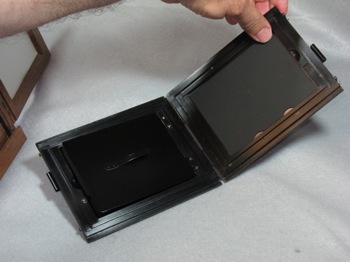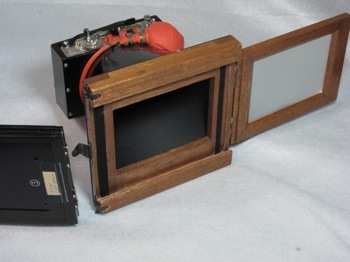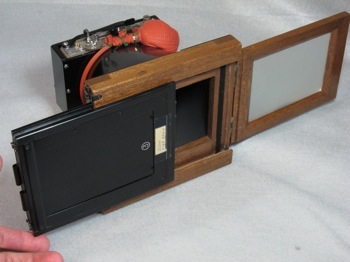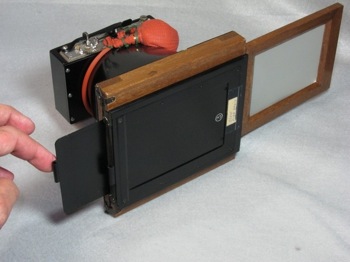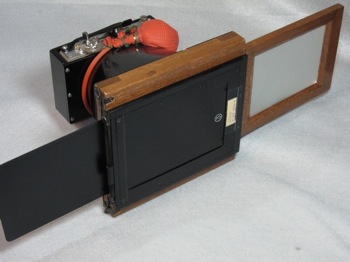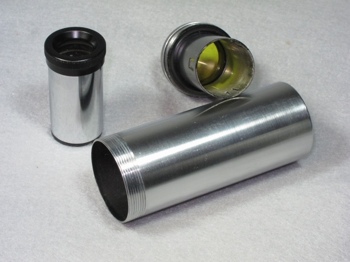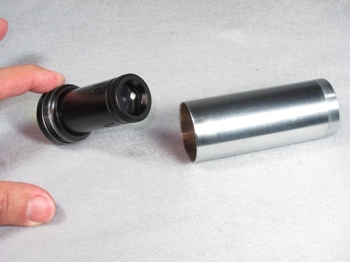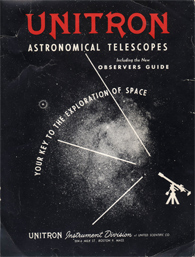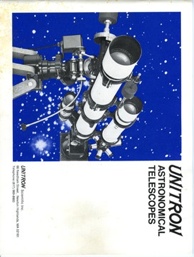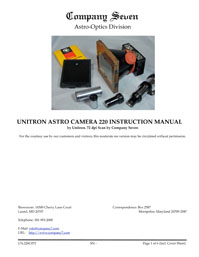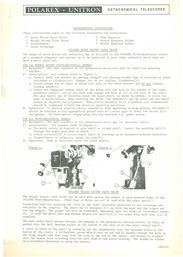Unitron Notes & Interesting Articles Index
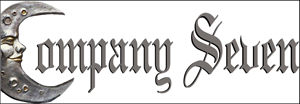
Unitron ASTRO-CAMERA, Model 220
an option available for film astrophotography with Unitron Achromatic Equatorial Telescopes
-
A discontinued product, posted for information purposes by Company Seven and with a historical perspective about the company who made it.
The Unitron illustration here are from literature and components of telescopes in Company Seven's museum display collection.
|
|
|
![]()
 Preface: in February 2011 Company Seven acquired a Unitron Model 142 - 3 inch Achromatic Photo-Equatorial Telescope for our museum collection. It was picked up by one of our technicians who on 1 May flew to Michigan to pack it securely and then drive it safely to Company Seven in Maryland. The telescope was uncommonly complete and well accessoried, with all components fundamentally in good condition. The Unitron ASTRO-CAMERA 220 set described here is among the many optional accessories that accompanied this acquisition.
Preface: in February 2011 Company Seven acquired a Unitron Model 142 - 3 inch Achromatic Photo-Equatorial Telescope for our museum collection. It was picked up by one of our technicians who on 1 May flew to Michigan to pack it securely and then drive it safely to Company Seven in Maryland. The telescope was uncommonly complete and well accessoried, with all components fundamentally in good condition. The Unitron ASTRO-CAMERA 220 set described here is among the many optional accessories that accompanied this acquisition.
Right: Unitron ASTRO-CAMERA with optional Kodak film, as displayed at Company Seven (67,593 bytes). The red pneumatic squeeze bulb and tube are wrapped around
the body of the camera when store. However, over the decades since it was made the rubber has stiffened and this original component is inoperable though easily replaced.
Click on image to see enlarged view (235,462 bytes).
UNITRON was among the better telescope brands sold in the USA in terms of mechanical quality, consistency, and comparative comprehensiveness of the system. These telescopes, mounts, and accessories were manufactured in Japan and distributed in the Americas from 1951 to about 1992. Their refracting telescopes were geared for the amateur astronomer and school science class markets. As Unitron prospered their offerings grew from the initial smaller models including the 2.4 inch telescope, up to massive 9 inch (230mm) telescopes made for permanent observatory installations. Unitron also came to offer microscopes and other scientific instruments, some that shared accessories of parts of accessories made for use with the astronomical telescopes.
The owner of Company Seven has for decades been on a mission to quietly promote science education through astronomy. We do this by helping to develop and sustain regional astronomy clubs, by donating equipment and expertise to start new astronomy programs overseas for elementary and junior high school age children locally with our own observatory and showroom, where we conserve and display telescopes and other instruments that have been worthy of note for attracting youth to astronomy, particularly since the beginning of the Space Age.
Company Seven had been keen to acquire Unitron telescopes for our display since these are among those landmark production telescopes that gave thousands of people their introduction to visual astronomy. While our Unitron Model 114 telescope represents the pinnacle of the smaller refracting telescopes, among the best that a beginning amateur throughout the 1950’s and into the 1960’s might have aspired to own, our Model 142 represents the most practical of the Unitron portable equatorial telescopes. The Unitron 4 inch models we also exhibit are so heavy and cumbersome that they tended not be used as often, nor would they fit (set up) in a typical room owing to their exceeding the height of most home ceilings. At Company Seven our ceilings can accommodate these and much larger telescopes, we display or store several Carl Zeiss refractors, and show modern state of the art Astro-Physics apochromatic refractors up to 8 inch for example, so in time for comparisons sake we may add a larger equatorially mounted Unitron to our display.
In the days (and nights) of film astrophotography it was a tedious task to successfully master the steps in advance, during, and after the exposure that would assure great results worthy of printing and then hanging on a wall. The astrophotographer had to now what film to select and to hypersensitive it if he was equipped to do so, then set up the mount and master attaining a precise Pole Alignment of the telescope equatorial mount while also setting the drive to track at the proper speed (to compensate for the rotational movement of the Earth), then find/center and frame the object, determine and set the most precise focus and lock the focuser draw tube, set the nominal exposure time, over longer sessions manually guide the main telescope mount while continuously observing through an auxiliary guide telescope, then process the film properly and print the film negative (dodging, burning in, etc.) onto paper. This all assumed the sky would be clear and steady throughout the session, after traveling hours to the remote location to set up all the required gear.
Those who succeeded in film astrophotography tended to have benefitted from reading and by comparing results with fellow astronomers, as did the author of this article. Only a small percentage of those who purchased a telescope between the 1950’s through to the 1970’s purchased the optional equipment required to do this work. While an even smaller percentage who did acquire the technology ever produced results worthy of hanging on their wall.
Many of our clients who are imaging planets, the Moon, and the Sun will find the shutter speeds of these old cameras are way too slow to produce the best results. This is because it is not fast enough to expose only during those often very brief moments of atmospheric steadiness. The slowness of their shutter is a limit imposed by the simplicity of the mechanism selected by the makers of these cameras, this however would not have been a major concern when these shutters mechanisms were first developed given the fairly slow ASA of those films that existed then.
With the introduction of advanced tracking telescope mounts, digital SLR and dedicated astronomical imaging cameras, and with image processing software astrophotography has become childs play even if the best results still require determination and yes - some luck.
The ASTRO-CAMERA 220 in our collection is among the rarer Unitron telescopes accessories in terms of numbers sold compared to the telescopes sold, but these still pop up for sale on the Internet. Most of them, if used very often at all, were well cared for.
Photography and astronomy go hand in hand and recording your observations can add a new dimension to your observing program. Astro-Camera 220 uses the telescope objective as the camera lens to photograph at the primary focus of the telescope or, with a telescope eyepiece in position, to project an enlarged image on the film. The camera may be used with any of the altazimuth models except No. 127 to photograph the sun, sunspots, the moon, solar and lunar eclipses as well as distant terrestrial objects. For stars, nebulae, clusters and comets, an equatorial mounting is necessary. The UNITRON Guide Telescope permits accurate tracking and a clock drive is essential for prolonged exposures. Astro-Camera 220 is pictured and described in more detail in a later page. For star fields, a camera of short focal ratio is of interest and UNITRON will offer a number of such astro-cameras of different apertures. Owners of suitable cameras may attach them to their telescopes as shown above by means of a UNICLAMP Camera Bracket which is available to fit 2.4", 3", and 4" refractors. The clamp encircles the tube and holds a screw threaded to fit the tripod socket of standard cameras. The bracket is designed primarily for equatorial models in which the telescope may be used to guide the camera during a time exposure. The UNIBALANCE Tube Assembly shown aove is used to balance heavy accessories."
The Unitron catalog published in 1972 described:
Model 220A for UNITRONS
Above: Components of the Unitron ASTRO-CAMERA, from Unitron ASTRO-CAMERA Instruction Manual (69,579 bytes).
The camera body incorporates a Thornton-Pickard Roller Blind type of curtain shutter so that the user can control when and for how long the film is to be exposed either for instantaneous or time exposures. The Thornton-Pickard shutter was once a common feature of early British Wooden plate cameras after their original introduction late in the 1880's, this has since been copied by many makers for use with cameras such as this by Unitron. The shutter mechanism allows the user to select the speed of the shutter from long bulb time exposure settings to 1⁄10, 1⁄20, 1⁄40, 1⁄60, 1⁄75, or 1⁄90 seconds.
Above: Shutter controls, from Unitron ASTRO-CAMERA Instruction Manual (55,378 bytes).
The camera employs a Film Magazine (film holder), each can hold up to two sheets of 4 x 5 inch sheet film or 3-1/4 x 4-1/4 inch glass plates. The magazine is loaded in a darkroom setting with one sheet of photographic film, that’s one sheet of film into each of both sides. Among the recommended films of the time would be KODAK EKTAPAN Film 4162, a fairly stiff black and white sheet film with the Estar Thick Base, this has since been discontinued but one may still be able to find refrigerated old stock or KODAK PROFESSIONAL T-MAX 100 Film / 100TMX film to use as an alternative.
The camera is attached onto the telescope, configured either for prime focus or projection photography. The prime focus method provides a comparatively small image circle at the film plane but with quicker exposure times than that required by projection photography. Other low magnification eyepieces, other than the provided 30mm eyepiece, could be employed.
Since Unitron refractors are achromatic telescopes a yellow filter is provided so that operators who typically employed black and white film could attain a sharper focus. The yellow filter is not necessary when taking astrophotos with the ASTRO-CAMERA 220 through apochromatic reflecting telescopes, or when exposing with color film. This filter is also helpful in attenuating energy for Solar photography, even when using the ASTRO-CAMERA 220 with apochromatic reflecting telescopes. But be certain to use an aperture stop to reduce the aperture of the telescope when photographing the Sun, and keep a cover over this aperture until you are ready to focus and take the photo since exposure of the camera shutter to the Sun will damage it.
Balance the Payload! as the camera is attached onto the telescope focuser the balance point will shift so that the telescope is rear heavy, and the Declination weight(s) position or quantity may no longer be sufficient to balance the payload. So you must compensate for the added weight by adjusting the position of the optical tube assembly forward or back on the telescope mount saddle, adding and/or adjusting longitudinal and Declination axis counterweights as necessary. To facilitate balancing along the longitudinal axis of the telescope optical tube Unitron offered the UNIBALANCE weight set, this was included as standard equipment with the Photo-Equatorial models. UNIBALANCE is shown on the Model 145 Photo-Equatorial telescope from the 1956 catalog extract above right.
The camera body incorporates a Ground Glass (frosted glass) focusing screen; the user opens the shutter of the camera to see the image of the target projected onto the screen and by examining the image one can adjust the telescope to attain nominal focus. The Ground Glass is moved to the side, and the Film Magazine is attached onto the camera body. The shutter speed is set, the shutter mechanism is manually wound to load up the spring. The Dark Slide is removed from the film holder to open the film to the shutter mechanism. Then the shutter is actuated by pressing the release button. To minimize the risks of inducing vibrations by touching a shutter the camera is equipped with a pneumatic bulb release, sometimes referred to as a ’bladder’, with flexible hollow tube that connects to the shutter. To trip the shutter one simply pushes the pneumatic bulb.
The red pneumatic bulb and tube for the shutter release are stored wrapped around the camera body, but given their age the rubber has stiffened and this original component is inoperable though easily replaced. Modern replacement versions of this pneumatic bulb release are often marketed as either "air shutter release" or "rubber bulb".
Right: Unitron ASTRO-CAMERA 220 wood case with coupling hardware and Kodak sheet film packages to the side (54,591 bytes).
The set included a selection of KODAK EKTAPAN Film 4162 sheet films of fine grain black and white 100 ASA and the faster 400 ASA. It is quite possible we could load then connect the camera set to a telescope and start snapping away on the next clear night!
Since our general policy is to conserve antiques - to clean and protect them from decay, we display this telescope and its accessories among our collection at our showroom cleaned and assembled but otherwise as it arrived.
Right: one of the first models offered by Unitron; a 2.4 inch Model 114 telescope of the Company Seven Museum Collection.
Japan had become the butt of 1950’s quality control jokes, “made in Japan” was generally not considered a compliment. But Japan’s industries improved, they became innovators, and the Japan of the late 1960’s into the 1980’s came to dominate the production of small moderate to excellent quality optics including telescopes, cameras, and microscopes. Unitron appealed to the more demanding clientele, a limited portion of the marketplace. And over the years Unitron was to stay loyal, one could argue mired, to their principles.
The US aspect of the history begins when United Trading Company acquired the rights to distribute the Nihon Seiko telescopes and their accessories in the USA. United Trading was founded by Lawrence Fine with offices and a shop at 204 Milk Street, Boston 9, Massachusetts. After the first couple of years in business United developed an acronym under which the telescopes might be more readily recognized, the trade name “UNITRON”.
Simultaneously the telescopes and accessories continued to be marketed in western block nations of Europe and most Commonwealth nations (Australia, New Zealand, etc.) under the trade name “POLAREX”. Of course in Japan these sold under their trade mark “Seiko Scope”. Some smaller quantity production lots of telescopes were made by Nihon Seiko Kenkyusho under other trade names, but these are not anywhere near as common as those bearing UNITRON or POLAREX trade names.
The astronomical telescopes product line offered initially included models built upon the 1.6" (40mm) and 2.4" (62mm) optical tube assemblies. The product line would include Altazimuth heads, German Equatorial heads, wood tripods for portable use, steel piers for permanent installation of the larger models, eyepieces and accessories including our ASTRO-CAMERA 220. Gradually the line expanded to offer 2 inch (50mm) and 3 inch (75mm) models. In May 1953 the 4 inch (102mm) models were announced soon followed by the observatory class 5 inch (125mm) and 6 inch (150mm) optical tube assemblies. These came to be among the most desired astronomical telescopes by the amateur and educational astronomy communities from the 1950’s and well into the 1970’s. But as newer and more innovative "apochromatic" refractor designs came into production, the Unitron which did not offer these new refractors, became less and less competitive. By 1992 the factory in Japan and the US based Unitron company were no longer in the telescope business, but continued to sell off remaining telescope and accessories inventory for years afterwards.
![]() Overview: The ASTRO-CAMERA is an optional film camera designed specifically to accommodate astrophotography through a telescope with a motorized tracking mount, such as the German Equatorial Mount that was sold with our Model 142 telescope. It was possible to use the camera with the telescope for terrestrial work too, given proper film and or filter selection and lighting of the object. Similar versions of this camera were sold for use with microscopes.
Overview: The ASTRO-CAMERA is an optional film camera designed specifically to accommodate astrophotography through a telescope with a motorized tracking mount, such as the German Equatorial Mount that was sold with our Model 142 telescope. It was possible to use the camera with the telescope for terrestrial work too, given proper film and or filter selection and lighting of the object. Similar versions of this camera were sold for use with microscopes.
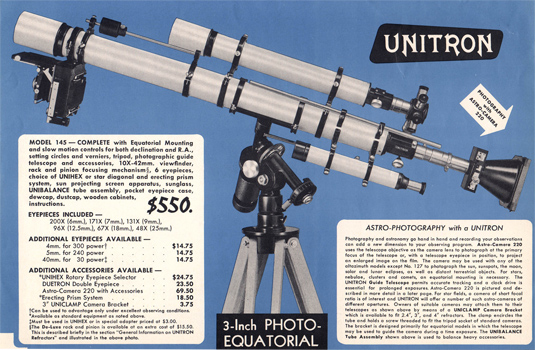 The Unitron telescope catalog and observing guide published in 1956 explains:
The Unitron telescope catalog and observing guide published in 1956 explains:
"ASTRO-PHOTOGRAPHY with a UNITRON
Right: Unitron 1956 Catalog, page 17 showing the ASTRO-CAMERA Model 220 with the Model 145 - 3 inch Photo-Equatorial telescope (142,612 bytes)"
Click on image to see enlarged view (522,900 bytes).
"The UNITRON ASTRO-CAMERA 220 ... is a light-weight camera designed especially for photography using the objective lens (or mirror) of the telescope as the principle optical element. A photo-ocular projects a magnified image at the film plane. The ocular can be removed to permit prime focus photography. An air operated curtain shutter of the Thornton-Pickard type gives speeds of 1/10 to 1/90 sec. in addition to bulb and time. Three double plateholders are included for 3-1⁄4 x 4-1⁄4" glass plates. Cut film adapters, to convert plate holders for cut film, are available in sets of 6. The camera comes complete with groundglass focusing back, extension tubes, a special 30mm f.l. photo-ocular, filter, clamps, air-operated shitter release, cabinet and instructions.
Notes about the above Unitron comments:
Model 220B for 1-1/4" o.d. eyepiece holders
![]() Operation:
The set consists of the machined steel coupling hardware to attach the camera to a telescope, 30mm projection eyepiece, a yellow filter, and the camera body and film holders with sheet film being optional. Instructions are provided, and for the convenience of our customers we provide them as .pdf files below and at our Unitron Archives index page.
Operation:
The set consists of the machined steel coupling hardware to attach the camera to a telescope, 30mm projection eyepiece, a yellow filter, and the camera body and film holders with sheet film being optional. Instructions are provided, and for the convenience of our customers we provide them as .pdf files below and at our Unitron Archives index page.

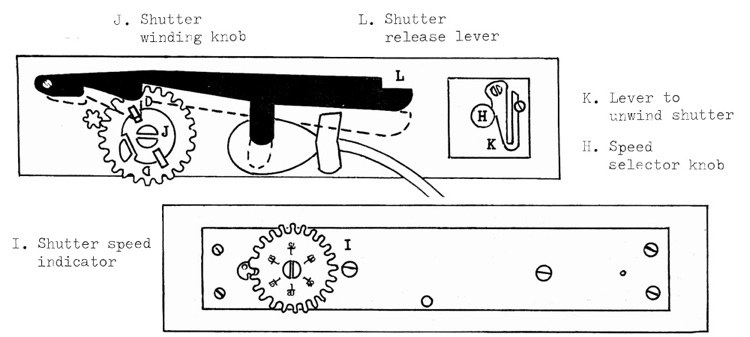
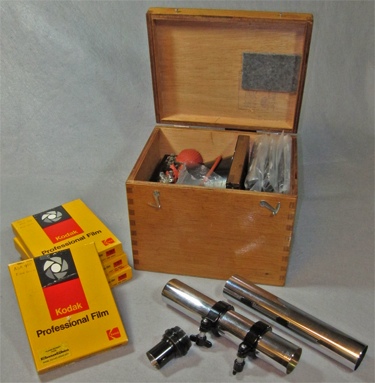 As mentioned above, the Unitron Model 142 Photo-Equatorial telescope that Company Seven acquired in February 2011 included not only the basic telescope with mount and tripod but it also included this ASTRO-CAMERA 220 and numerous other Unitron and third party options, most listed in the table below. The telescope optical tube assembly, the German Equatorial Mount, the UNIXEX, DEUTRON, and ASTRO-CAMERA are each provided with their own separate fitted wood boxes. The solid wood case arrived in good condition, with no damage of note to the support braces inside as is often seen in other examples. The case needed only some cleaning and conditioning before being added to the display.
As mentioned above, the Unitron Model 142 Photo-Equatorial telescope that Company Seven acquired in February 2011 included not only the basic telescope with mount and tripod but it also included this ASTRO-CAMERA 220 and numerous other Unitron and third party options, most listed in the table below. The telescope optical tube assembly, the German Equatorial Mount, the UNIXEX, DEUTRON, and ASTRO-CAMERA are each provided with their own separate fitted wood boxes. The solid wood case arrived in good condition, with no damage of note to the support braces inside as is often seen in other examples. The case needed only some cleaning and conditioning before being added to the display.
Click on image to see enlarged view (148,280 bytes).


![]() Background: the telescopes and accessories marketed in the Americas under the trademark “UNITRON” were produced by Nihon Seiko Kenkyusho, Ltd. of Nozawa, Setagaya-ku, Tokyo, Japan. This company and its affiliates manufactured telescope and other scientific instruments. We have no substantial information about how Nihon Seiko Kenkyusho came to be, or when they developed their line of fine achromatic refracting telescopes. However, the company was established at least as far back as the the mid 1930’s, then furnishing fine achromatic telescopes of at least up to 125mm aperture to universities under the POLAREX and Seiko Scope trademarks. By 1951 the company had emerged from the ashes of the war and offered an their first assortment of what was to become an extraordinarily well integrated and accessorized line of telescopes, mounts, and accessories.
Background: the telescopes and accessories marketed in the Americas under the trademark “UNITRON” were produced by Nihon Seiko Kenkyusho, Ltd. of Nozawa, Setagaya-ku, Tokyo, Japan. This company and its affiliates manufactured telescope and other scientific instruments. We have no substantial information about how Nihon Seiko Kenkyusho came to be, or when they developed their line of fine achromatic refracting telescopes. However, the company was established at least as far back as the the mid 1930’s, then furnishing fine achromatic telescopes of at least up to 125mm aperture to universities under the POLAREX and Seiko Scope trademarks. By 1951 the company had emerged from the ashes of the war and offered an their first assortment of what was to become an extraordinarily well integrated and accessorized line of telescopes, mounts, and accessories.
This instrument has the UNIHEX A accessory attached holding the four provided eyepieces (309,461 bytes).
Click on images to see a striking enlarged view (1,014,604 bytes).
![]() UNITRON ASTRO-CAMERA 220 Prices*:
UNITRON ASTRO-CAMERA 220 Prices*:
| Item | Price In 1956 | Price in 1974 | Price in 1985 |
|---|---|---|---|
| Astro Camera 220A, for Unitron | $69.50 | 155.00 | N/A |
| Astro Camera 220B, for 1-1/4" Focusers | $69.50 | 155.00 | N/A |
The Internet continues to evolve and bring the world closer than ever, among the benefits are all the resources that helped one to not only find these telescopes used, or rare parts to make restore them, but also literature. Here are Unitron documents scanned by the host of this site:
![]() Additional Reading From Our Unitron Archives:
Additional Reading From Our Unitron Archives:
If you are a novice who has acquired a telescope such as this then instead of relying on this manual alone, we urge you to look for better written contemporary observational astronomy guide books (Nighwatch for example) and affiliate yourself with an astronomy club.
We invite you to visit our showroom near Washington, D.C. to see our Unitron 114 first hand or contact us by E-Mail to info@company7.com, or by telephone 301-953-2000. The showroom is open Monday to Friday 11 am to 6 pm, Saturday 11 am to 5 pm. We are closed on Sundays, on U.S. Holidays, and from 25 December through 1 January inclusive.
Contents Copyright 2011 Company Seven and respective contributors - All Rights Reserved



